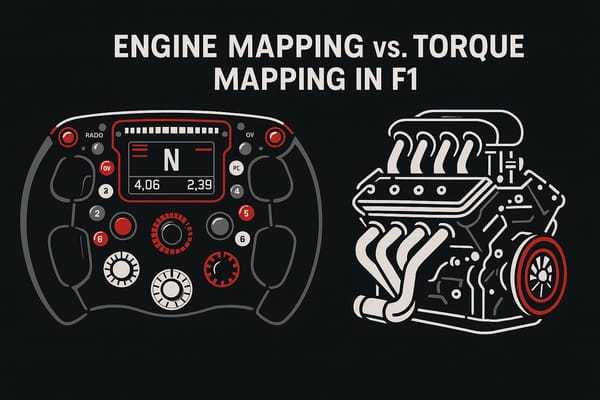F1 Net Zero Plan: Key Steps to 2030
Explore Formula One's ambitious plan to achieve net-zero carbon emissions by 2030, including sustainable fuels and innovative practices.

Formula One is on a mission to achieve net-zero carbon emissions by 2030, transforming how the sport operates and influences global industries. Here's a quick summary of the key steps they're taking:
- Sustainable Fuels: By 2026, F1 cars will run on 100% sustainable fuel, reducing CO₂ emissions by up to 96%.
- Renewable Energy: Race events are transitioning to renewable energy sources, with some achieving over 90% emissions reductions.
- Logistics Overhaul: Using biofuel-powered trucks and sustainable aviation fuel, F1 has already cut logistics emissions by 83%.
- Event Management: Promoters are adopting renewable energy, reducing waste, and introducing sustainable fan transportation.
- Progress So Far: Since 2019, F1 has reduced its carbon footprint by 13% and continues to drive innovation in sustainability.
With these initiatives, F1 is not only reshaping motorsport but also inspiring changes across industries. Keep reading to learn how they're making it happen.
F1 Announces Plans To Be Net Zero Carbon By 2030 | F1 Sustainability
Sustainable Fuel Development
Formula One's shift toward sustainable fuels represents a significant technological evolution. Collaborating with the FIA and partners such as Aramco, F1 is working to create fuels that reduce CO₂ emissions while maintaining the high performance expected in motorsport. This initiative comes with a clear timeline and a host of engineering hurdles, which we’ll explore further.
Timeline for Sustainable Fuel Implementation
By 2025, F2 and F3 cars are set to test 100% sustainable fuel, setting the stage for F1's transition in 2026 under new engine regulations. These regulations will limit each car to 70 kg of fuel during a Grand Prix and shift the focus from maximum fuel mass flow to maximum energy flow. Currently, F1 cars use E10 fuel, which includes 10% ethanol derived from renewable sources. The leap from 10% to 100% sustainable fuel is a bold goal, and F1’s technical teams are determined to achieve it without sacrificing competitive performance. This transition introduces a range of engineering challenges, which we’ll delve into next.
Engineering and Impact
The journey to develop sustainable fuels is a complex engineering puzzle. F1's Chief Technical Officer, Pat Symonds, shared insights into the process:
"It's been a challenging process... At the time I was first talking to people about this, no one knew what I was talking about, and to be honest I'm not sure I did really, so I've done an awful lot of research into it. We've worked closely with the FIA, who have got a couple of very good fuels specialists and we've had a lot of help from our partner ARAMCO".
So far, over 39 blends of sustainable fuel have been tested, each evaluated for its impact on engine performance and emissions. These fuels are designed as "drop-in" replacements, meaning they can be used in existing internal combustion engines without any modifications. This approach not only benefits Formula One but also has the potential to transform the broader automotive industry. Ross Brawn, F1's Managing Director of Motorsports, explained the environmental potential:
"We're working on an E fuel where the carbon circle is completely neutral so the carbon utilised to produce that fuel is the same quantity as the carbon emitted from the internal combustion engine. It means that the engines do not add anything to the carbon dioxide in the atmosphere".
The production of synthetic fuel involves several intricate steps: splitting water into hydrogen and oxygen via electrolysis, capturing carbon dioxide from the air using direct air capture (DAC), converting CO₂ and hydrogen into carbon monoxide and water through a reverse water–gas shift reactor, and finally, creating hydrocarbons using the Fischer–Tropsch process. This process ensures that the fuel uses carbon already in the atmosphere, avoiding new emissions.
Comparison: Sustainable Fuel vs. Traditional Fuel
F1’s commitment to sustainability highlights the differences between traditional and sustainable fuels, spanning environmental impact, compatibility, and scalability.
| Aspect | Traditional Fuel | Sustainable Fuel |
|---|---|---|
| CO₂ Impact | Adds new CO₂ to the atmosphere from fossil sources | Carbon neutral - reuses existing atmospheric CO₂ |
| Engine Compatibility | Requires conventional modifications | Drop-in replacement; no engine changes needed |
| Performance | Established baseline | Engineered to match or exceed traditional performance |
| Production Source | Extracted from finite fossil reserves | Created from renewable resources using DAC technology |
| Scalability | Limited by fossil fuel availability | Scalable through renewable energy and synthetic processes |
| Road Car Application | Commonly used in about 1 billion vehicles | Compatible with existing vehicles as a drop-in replacement |
Performance remains a critical factor, especially in the demanding world of Formula One. Amer Amer, Aramco’s chief technologist of transport technologies, emphasized motorsport’s role in validating these fuels:
"Motorsport is a platform to really validate the performance of the fuels that we're developing".
The FIA requires these fuels to function as drop-in solutions, ensuring compatibility with the roughly 1 billion gasoline-powered cars still on the road. Beyond motorsport, this innovation could have a far-reaching impact. As Sebastian Hirsz, bp's Lead Advisor for Mobility Policy, pointed out:
"The 2026 rule changes are prompting a lot of really good kind of research and development into (different sustainable fuels), considering what we could deploy in road gasoline".
This work is critical, given that by 2030, only 8% of the estimated 2 billion vehicles on the road are expected to be pure Battery Electric Vehicles. F1’s efforts are paving the way for a more sustainable future, not just for racing but for the global automotive industry as a whole.
Energy Efficiency and Changes
F1 continues to refine its approach to energy efficiency, focusing on every aspect of its operations. By revamping power sources, transportation, and logistics, the organization is taking significant steps toward its goal of achieving net-zero carbon emissions. These efforts reflect F1's commitment to rethinking how energy is sourced and used across the sport.
Transition to Renewable Energy
F1 is reshaping how it powers race weekends by incorporating renewable energy systems. A significant milestone was the Emilia-Romagna Grand Prix in May 2025, where a groundbreaking low-carbon energy solution was introduced. This system, provided by Aggreko, combined hydrotreated vegetable oil (HVO), solar panels, and battery energy storage systems (BESS). The result? A remarkable 90% reduction in carbon emissions compared to traditional power methods.
Ellen Jones, Head of ESG at Formula 1, highlighted the importance of these advancements:
"We remain on track to be Net Zero by 2030, and it is new technologies and innovations such as this that will see us hit our goal".
The European races in the 2025 season have become a testing ground for these renewable energy initiatives, with entire paddocks now running on sustainable power sources.
Logistics and Freight Changes
With transportation accounting for nearly half of F1's carbon footprint, rethinking logistics is a key part of the journey to net zero. F1 has introduced major changes to both ground and air transport, aiming to significantly reduce emissions.
Ground Transportation Revolution
DHL’s biofuel-powered truck fleet has become a cornerstone of F1’s logistics strategy. During the 2023 European season, these trucks reduced logistics emissions by an impressive 83% compared to conventional fuels. Encouraged by this success, DHL expanded its fleet from 18 to 37 trucks in 2024.
Ellen Jones praised the impact of these efforts:
"It is great to see how our logistics operations can transform to achieve our Net Zero by 2030 goal. Reductions such as 83% with the use of the biofuel‑powered trucks provide a fantastic platform to build upon, which we will analyse and then continue to deliver in our 2024 season, ensuring that these savings move from a single initiative to business‑as‑usual carbon reductions. Transport and logistics make up a significant portion of our carbon footprint in our sport, and it is crucial to have like minded partners like DHL that are committed to working with us to drive these down and help us realise our net zero target."
Aviation Improvements
F1 has also made strides in reducing emissions from air transport. By using Sustainable Aviation Fuel (SAF) for 20% of its cargo flights, in partnership with DHL Global Forwarding and Qatar Airways, emissions per flight have dropped by approximately 80%. This shift has led to a reduction of over 8,000 metric tons of CO₂ equivalent. Starting with the 2024 Australian Grand Prix, SAF was used for cargo flights to non-European races, resulting in a 19% emissions decrease for flyaway events. Additionally, DHL’s use of Boeing 777 aircraft, which are more efficient than older models, has cut emissions by an additional 17%.
Paul Fowler, Head of DHL Motorsports Logistics, emphasized their shared commitment to sustainability:
"Our longstanding partnership with Formula 1 is built on a shared passion for innovation and excellence. We are committed to using our expertise to support Formula 1 in transporting cars and other equipment around the world in the most efficient way possible. With 40 years of expertise in motorsports logistics, we are focused on identifying ways to cut down greenhouse gas emissions and making motorsport more sustainable with every step we take."
FIA Sustainability Management Accreditation

F1 is also pursuing FIA Sustainability Management Accreditation to implement standardized environmental practices across the sport. This accreditation ensures that teams, venues, and events adhere to consistent sustainability measures, fostering a unified approach to reducing environmental impact within the F1 ecosystem.
Race and Event Management
Formula 1 is expanding its push for net-zero emissions to include race events, focusing on transforming broadcast production and event management. The goal? To minimize environmental impact while maintaining the excitement fans expect. These operational changes are a key part of F1's broader strategy to reshape its approach to sustainability.
Carbon-Neutral Broadcast Productions
F1 hit an important milestone in 2021 at the British Grand Prix, earning albert certification for its broadcast production. This certification highlighted significant steps toward reducing carbon emissions. For instance, the team swapped out 7,500 liters of diesel for HVO fuel in generators, and 70% of staff transportation relied on hybrid or zero-emission vehicles. Catering also leaned into plant-based options to reduce meat consumption. Meanwhile, the Remote Broadcast facility in Biggin Hill operated on renewable energy, supported by low-energy lighting and an energy-saving campaign called "Switch it Off!" To address any remaining emissions, F1 partnered with the albert scheme's official CO₂ offset program. This event became a model for future carbon-neutral broadcasts across other races.
Promoter Standards
F1 has also introduced stricter sustainability requirements for event promoters. Ellen Jones, F1's Head of Energy, Sustainability and Governance, explained this new approach:
"The first thing that we did when I started here about two years ago is to update contracts, you need to say what are our expectations to host a Formula 1 event".
These updated contracts now mandate clear sustainability goals, annual action plans, and regular progress reviews. In 2022, F1 issued guidelines focusing on six critical areas: Plastic & Waste, Local Fan Travel, Wellbeing & Nature, Local Community, Energy, and Carbon. Today, over 75% of race promoters use renewable energy at their events, and some circuits have already transitioned to 100% renewable energy. Additionally, venues are developing robust sustainable transportation systems to support these efforts.
Jones highlighted the positive reception from promoters:
"We've had a fantastic response to how we work with our promoters. Not just with energy at event, but a number of critical areas for us, such as local fan travel, all the way through to local community".
These contractual updates align with F1's technical and logistical innovations, all driving toward the net-zero goal.
Table: Current vs. Planned Event Practices
| Operational Area | Current Practice | Planned Improvements |
|---|---|---|
| Power Generation | 75% of promoters using renewable energy | 100% renewable energy at all events by 2030 |
| Waste Management | Reusable plates/bowls, water refill stations | Full circular economy implementation |
| Fan Transportation | Limited sustainable transport options | Comprehensive public transport and cycling |
| Broadcast Operations | Albert-certified at select events | Carbon-neutral broadcasts at all races |
| Food Services | More plant-based options | Zero food waste and fully sustainable catering |
| Venue Infrastructure | Solar installations at some circuits | All venues powered by renewable sources |
These efforts underscore F1's dedication to innovation and align event operations with its broader sustainability goals.
Some events already stand out as leaders in this area. For example, during the 2024 Australian Grand Prix, over 15,000 plates and bowls were reused, 60,000 liters (approximately 15,850 gallons) of water were refilled - preventing the use of about 122,000 single-use bottles - and 11 tons of food (around 24,250 pounds) were collected to create 22,000 meals for distribution. Similarly, the Las Vegas Grand Prix embraced recycling, achieved net-zero water use, and repurposed construction waste into wood chips for local parks.
Ellen Jones emphasized the core principles driving these changes:
"When we talk about the circular economy, it really breaks down to the lessons we learned in school. It's reduce, reuse, recycle. These are fundamental principles of delivering sustainability".
These initiatives showcase F1's commitment to measurable progress in its journey toward net-zero emissions, setting a strong foundation for the future of sustainable racing.
Progress Tracking and Future Milestones
Formula 1 has been steadily advancing toward its net-zero carbon emissions goal since unveiling its ambitious plan on November 11, 2019. With clear benchmarks, advanced monitoring systems, and strategic partnerships, the sport is driving change not just within its own operations but across the motorsport industry.
Key Achievements Since 2019
F1 has made notable strides in cutting its carbon footprint, achieving a 13% reduction in absolute emissions by 2023 compared to the 2018 baseline. Back in 2019, the sport's total carbon emissions reached 256,551 tonnes of CO₂, with 72.7% stemming from transport and business travel. Since then, focused initiatives in logistics and renewable energy have delivered measurable results.
Logistical improvements have been a major factor in reducing emissions. At the same time, energy generation at race venues has undergone significant changes. For example, the Austrian Grand Prix piloted a centralized power system utilizing renewable energy sources like hydrotreated vegetable oil (HVO), biofuel, solar panels, and battery storage, resulting in over a 90% reduction in emissions compared to the previous year. Encouraged by this success, similar systems were tested at the Red Bull Ring, Hungarian Grand Prix, and Monza in 2024.
Adoption of renewable energy by race promoters has also surged. In 2023, more than 75% of promoters incorporated renewable energy into their events, up from 50% in 2022. A standout example is the Bahrain International Circuit, where a solar farm generated 5.28 MW of clean energy between the 2022 and 2023 Grands Prix.
Collaborations Driving Industry Change
F1's progress has been amplified by partnerships that bring together expertise from various industries, setting new standards for motorsport operations.
DHL, a long-standing logistics partner, has played a vital role in transforming how events are delivered. Jonny Haworth, Director of Commercial Partnerships at Formula 1, highlighted the importance of this collaboration:
"As our longest-standing partner, DHL have become such a crucial part of the delivery of our events, so we're delighted to continue that successful collaboration for many more years".
Aggreko has revolutionized power generation at European races, supporting F1's sustainability goals. Ellen Jones, Head of ESG at Formula 1, explained:
"The delivery of our Net Zero by 2030 commitment is driven by new technologies and new ways of working. With Aggreko's support, Formula 1 is taking another step to reduce emissions across the Paddock".
Another critical partnership involves Aramco, the FIA, and Formula 1, focusing on sustainable fuel development. By 2024, F2 and F3 cars ran on 55% Aramco advanced sustainable fuel, while FIA medical and safety cars used 40% sustainable fuel. The goal is to have race cars running entirely on sustainable fuels by 2026, potentially slashing emissions by up to 96%.
Teams are also contributing to these efforts. Simon Randall, Head of Safety, Sustainability and Facilities at Aston Martin Formula One Team, emphasized the importance of team-level innovation:
"We wanted to be at the forefront of delivering more efficient and sustainable solutions, quickly".
Future Targets and Monitoring
F1 has set its sights on cutting absolute emissions by at least 50% by 2030, compared to 2018 levels, with the remaining emissions to be offset. Using 2018 as a baseline, the sport is working toward achieving net-zero emissions through a comprehensive approach that includes sustainable fuel development, improved logistics, and energy efficiency.
The focus remains on reducing emissions at their source - through travel, logistics, and energy use at factories and events - before turning to offsetting. F1 is also collaborating with stakeholders to enhance data collection, with comprehensive data for 2023 already being gathered. This data not only tracks progress but also provides a model for effective carbon reduction strategies.
Stefano Domenicali, President & CEO of Formula 1, underscored the organization's dedication:
"Sustainability is one of the most important factors to us not only as a sport, but as a business... Over the past four years we have made significant progress and we remain very focused on our goals, and I'm excited to see the impact we can have".
A major milestone on the horizon is the 2025 rollout of low-carbon energy systems at all European Grands Prix, which is expected to cut event emissions by more than 90%. Moving forward, F1's tracking system will monitor key metrics like renewable energy adoption, logistics emissions, and the implementation of sustainable fuels. Ellen Jones summed up F1's unique position in leading these efforts:
"Formula 1 as a sport is uniquely positioned to take action through our global reach and technological leadership".
Conclusion: Formula One's Commitment to a Cleaner Future

Formula One's journey toward net-zero emissions is setting a powerful example for industries worldwide. With a global fanbase of over 700 million, F1 has turned its immense influence into a platform for advancing sustainability well beyond the racetrack.
The sport's ambitious plan to achieve net-zero by 2030 reflects a vision for long-term change and a broader societal impact. A key component of this plan is the development of 100% sustainable fuel, slated for use in F1 cars by 2026. This initiative not only highlights the potential of racing technology to revolutionize transportation but also positions F1 as a leader in sustainable innovation. The commitment to this vision is championed by F1 leadership, as reflected in the words of Stefano Domenicali, President & CEO of Formula 1:
"F1 has been innovating and influencing wider society for over 70 years, and we've turned that expertise and insight to sustainability".
Collaborations with industry partners have further validated these advancements, particularly in logistics and fuel technology, delivering tangible results.
Beyond environmental goals, F1 is also addressing social and economic dimensions of sustainability. By prioritizing diversity, inclusion, and carbon reduction, the organization is creating a holistic model for transformation that resonates across industries.
As F1 moves closer to its 2030 net-zero target, the innovations born from this journey are expected to ripple across sectors. From sustainable aviation fuels to renewable energy systems that slash event emissions by over 90%, the sport is proving that high-performance competition can coexist with environmental responsibility.
This isn't just about reaching a milestone - it's about demonstrating that one of the world's most advanced sports can lead by example. F1's efforts inspire fans, partners, and industries alike to pursue their own sustainable paths, reinforcing its role as a trailblazer in creating a greener future for all.
FAQs
How will F1's switch to 100% sustainable fuel affect race car performance?
Formula One is gearing up for a game-changing shift to 100% sustainable fuel, aiming to keep its race cars performing at peak levels while slashing carbon emissions. What’s impressive is that these fuels are chemically identical to traditional ones, so teams won’t need to overhaul their engines. This means the transition can happen seamlessly, without sacrificing speed or reliability on the track.
These sustainable fuels have already been put to the test in the F2 and F3 championships, delivering strong results and setting the stage for their introduction in F1 by 2026. What makes them particularly noteworthy is their carbon-neutral design - any carbon released during use is balanced by the carbon absorbed during production. This aligns perfectly with F1’s ambitious goal of achieving net-zero emissions and underscores its commitment to leading the charge in sustainable automotive advancements.
What challenges does Formula 1 face in reaching net-zero carbon emissions by 2030?
Challenges on Formula 1's Path to Net-Zero Emissions
Formula 1 has set its sights on achieving net-zero carbon emissions by 2030, but the road ahead is far from simple. One of the biggest obstacles lies in the logistics of global operations. With a packed race calendar that spans continents, the transportation of equipment, personnel, and infrastructure contributes significantly to F1's carbon footprint. Interestingly, the race cars themselves are responsible for only about 1% of the sport’s total emissions, making the broader operational impact a key area to address.
Another major challenge is the creation and implementation of 100% sustainable fuels, which are slated to debut in 2026. These fuels must undergo rigorous testing to ensure they not only work seamlessly with current engines but also maintain the high-performance standards fans and teams expect. Beyond the technical hurdles, there's also a need for a mindset shift across the sport. Teams, manufacturers, and partners must embrace sustainability as a core principle, influencing every decision and action within the Formula 1 ecosystem.
Although progress has been made, overcoming these challenges will require constant innovation, teamwork, and a shared commitment to hitting the 2030 target.
How is F1's sustainability plan shaping the future of the automotive industry?
Formula One is steering toward a greener future, proving that cutting-edge technology and environmental goals can work hand in hand. With a commitment to achieving net-zero carbon emissions by 2030, F1 is leading the charge by developing sustainable fuels. These fuels are designed to maintain the high performance F1 is known for - without sacrificing speed or efficiency. This bold move is sparking interest among car manufacturers, encouraging them to explore similar fuel innovations for everyday vehicles, which could reshape the future of transportation.
Beyond fuels, F1 is embracing renewable energy at race venues and working on eco-friendly tire technologies. These efforts not only reduce the sport's carbon footprint but also set a powerful example for the automotive industry. From tire advancements to energy-efficient production methods, F1's initiatives are inspiring meaningful changes across the board.




